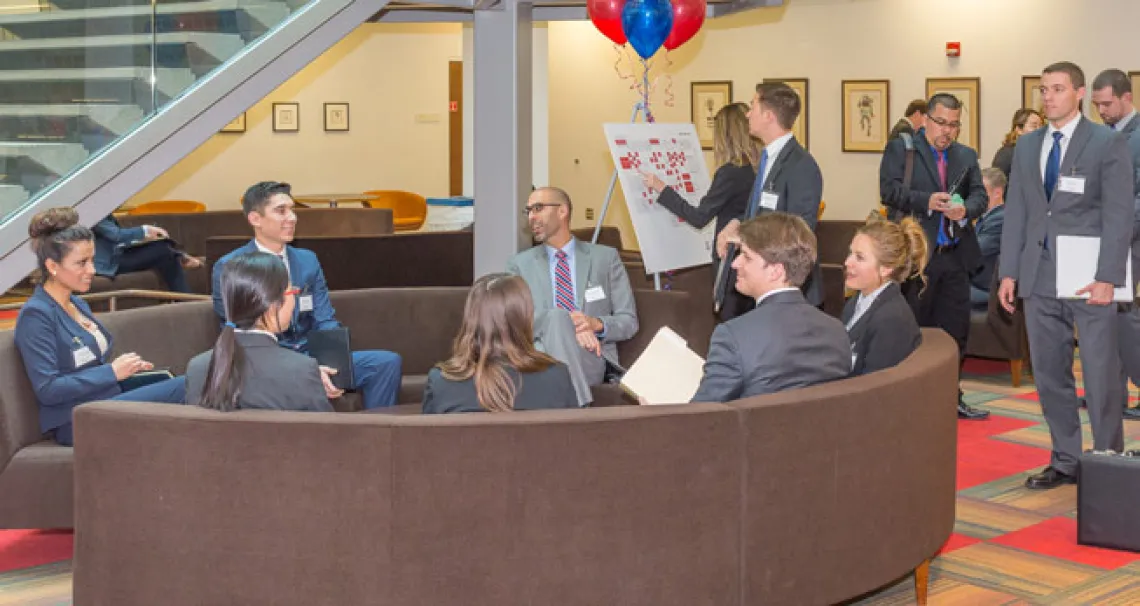Record-Setting Year for Arizona Law Employment

For the second year in a row, University of Arizona Law has achieved record employment rates for its JD students.
Class of 2015 Graduates
For the Class of 2015, the overall employment rate 10 months after graduation was 90.3 percent, the highest in recent history. Out of the class of 144 graduates, 61.8 percent had full-time, long-term jobs that require bar passage (compared to 59.2 percent nationally across all law schools). An additional 16.7 percent had JD-advantage or professional positions, while 2.7 percent were pursuing full-time graduate education.
The Class of 2015’s unemployment rate—those who were unemployed and seeking work—was 2.8 percent (representing four graduates). The national unemployed and seeking rate was 9.7 percent.
“These numbers point to the quality of Arizona Law students who graduate ready to practice and who routinely pass the bar at rates well above the state and national average," says Dean Marc Miller. "I’m enormously proud of them and the Career Development Office staff who are consistently innovating in an effort to respond to the ever-evolving legal job market."
Arizona Law’s private sector employment rate increased to 46.2 percent, up by more than 7 percent from the Class of 2014. The next largest employment sector was government (18.5 percent), followed by judicial clerkships (16.2 percent).
About half of the class—54.2 percent—found employment in Arizona, followed by 9 percent in California and 4.2 percent in New York. The Class of 2015 had the highest level of out-of-state employment in the past seven years. On the international front, 4.9 percent went to work in a foreign country.
“Our goal is to leverage our resources and our career counselors’ nearly 30 years of combined legal practice experience to develop a specific plan for each student to achieve their unique career objectives,” says Karen Kowalski, Arizona Law’s assistant dean for career development since 2013. “I am extremely happy for the talented members of our Class of 2015, and I hope they find success in their first positions out of law school and always.”
1L and 2L Summer Placement
Arizona Law continues its strong record of summer placement, with 95 percent of this year’s 1L class reporting summer positions and 94.3 percent of the 2L class reporting summer positions.
Students earned judicial externships in Tucson, Phoenix, and San Diego, while public sector placements are taking students throughout Arizona and to California, Washington, D.C., New Mexico, Oregon, and Maryland. Public sector summer positions for Arizona Law students include the U.S. Department of State, Arizona Attorney General’s Office, Committee for Public Counsel Services, Goldwater Institute, San Francisco Public Defenders Office, and the Federal Trade Commission.
A Move to “On-Demand” Counseling
This latest round of employment statistics comes on the heels of a year in which Arizona Law’s Career Development Office (CDO) continued to expand its offerings, including hosting more than 15 interviewing events, Meet-the-Employer receptions, and other networking opportunities.
Last year employers scheduled 419 interviews with students in fall interview programs in Tucson, Phoenix, Los Angeles, Las Vegas, Denver, and Albuquerque. In the Phoenix Interviewing Program alone, more than 24 firms interviewed students for summer associate jobs. That event was preceded by a Meet the Employers reception that allowed students to mingle with employers about a month before meeting for an interview.
In September 2015, CDO hosted the first ever Arizona Law Career Mixer, an informal networking event that drew more than 200 students, alumni, attorneys, judges, faculty and staff to the college from across the state.
Kowalski says the CDO team is also offering more “on-demand” counseling tools to accommodate students’ busy schedules that may limit their ability to attend in-person events. One example: launching a podcast series that offers on-the-go guidance about careers, job searches, and maximizing application materials.
“We try to be responsive and pay attention to student preferences so that students can take advantage of as many opportunities as possible,” says Kowalski, adding that the office even adjusted the time of day online job applications were due to ensure students were submitting materials during a time when staff were available to assist with any technical problems. “We want to offer counseling tools that are as unique as our students’ career objectives.”
